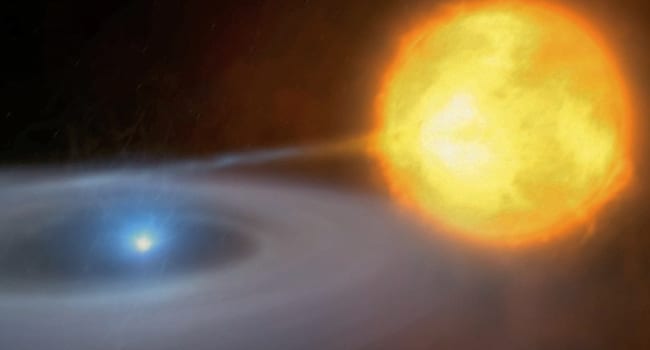“We observed an exotic stellar binary system using both X-rays and radio waves,” said University of Alberta astrophysicist Craig Heinke. “Only 10 years ago, we knew of neutron stars that were pulsars, and neutron stars that accreted matter from companion stars, but none that switched back and forth.”
The scientists of the Milky-way ATCA and VLA Exploration of Radio-sources in Clusters (MAVERIC) team observed the unusual switching in the new image, using data compiled by NASA’s Chandra X-ray Observatory over nearly 15 years.
The stellar system was described in a 2018 study led by U of A physics PhD graduate Arash Bahramian, now at Curtin University. In the system, a normal star and dense neutron star orbit each other, and at times, stellar material is seen to be absorbed by the denser neutron star – a phenomenon sometimes referred to as stellar vampirism.
But unusually, at other times, the flow stops and the neutron star’s strong magnetic field accelerates particles to near light-speed, generating strong radio emissions – known as a pulsar.
“We know of only a handful of these stars that switch between states, called transitional millisecond pulsars,” said U of A astrophysicist Gregory Sivakoff, who is a co-investigator on the MAVERIC team.
“We had long thought that neutron stars had to eat material from a nearby star to spin up to such fast speeds, but it was only with transitional millisecond pulsars that we found the silver bullet that proved our hypothesis was likely true.”
Only three confirmed examples of these identity-changing systems are known, explained Sivakoff. The first was discovered in 2013 using the orbiting Chandra telescope and several other X-ray and radio telescopes – which he said makes the new image of the system all the more exciting.
“The first of these systems discovered elicited enormous excitement, as they represented a holy grail of X-ray astronomy: to show that accreting neutron stars can ‘turn on’ as pulsars,” said Heinke.
“But they have also generated a host of other questions, and it’s been very hard to find systems like this to learn more. This find opens up a new way to search for these objects as we learn more about them, and hopefully to start to unravel their mysteries.”
| Andrew Lyle
This article was submitted by the University of Alberta’s online publication Folio, a Troy Media content provider partner.
The views, opinions and positions expressed by columnists and contributors are the author’s alone. They do not inherently or expressly reflect the views, opinions and/or positions of our publication.

